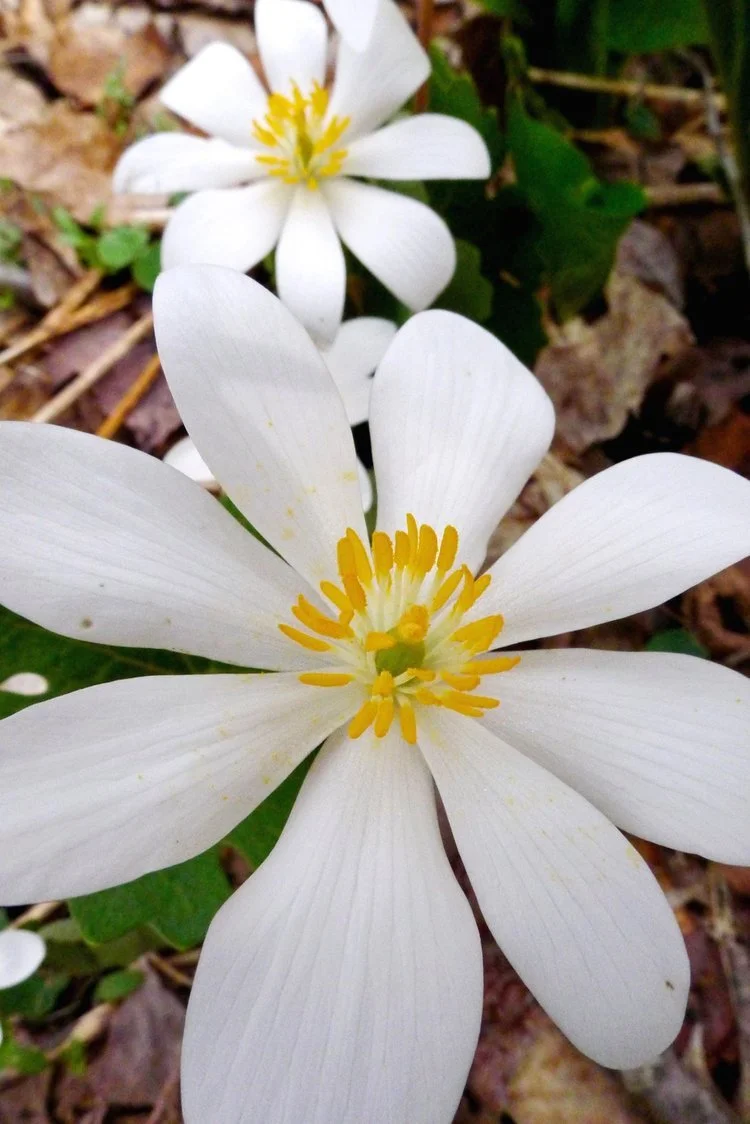Bloodroot (Sanguinaria canadensis)
Photo by Ilana Sobo. Sherman, Connecticut
Bloodroot
Bloodroot (Sanguinaria canadensis)
*Please note the following
Bloodroot (Sanguinaria canadensis) is a beautiful and potent plant, but it is important to approach its use with caution and respect. As a native plant, bloodroot is threatened by overharvesting, making it crucial to protect and conserve this species. In herbal medicine, it should not be exploited or used recklessly, as improper harvesting or preparation can be harmful to slow growing stands of plants. Ethical and sustainable practices, such as sourcing from cultivated plants or supporting responsible wild harvesting, are essential to ensure that bloodroot remains available for future generations while preserving its natural habitats. Always seek guidance from trained herbalists or native plant educators when considering the use of this powerful plant.
Bloodroot is a captivating wildflower native to North America, revered for its striking white blooms and vibrant red-orange sap. Traditionally, this perennial plant held a significant place in the practices of Native American tribes, who utilized its rhizomes for a variety of medicinal and ceremonial purposes. The bright sap was used as a natural dye for clothing, basketry, and body paint. Medicinally, it was prepared in small quantities to help respiratory issues, warts, and skin conditions, though it was always handled with care due to its toxic properties. Bloodroot also played a symbolic role in rituals and was believed to offer protection and connection to the spiritual world.
Despite its historical significance, modern use of bloodroot is limited due to its potent and potentially harmful alkaloids, particularly sanguinarine, which can cause severe irritation or tissue damage. The plant is not considered safe for internal consumption, as it can be toxic to the liver and other organs, and it should only be used externally under the guidance of a qualified clnical herbalist. Today, bloodroot is primarily valued as a garden plant and as a endangered spring ephemeral requiring our protection and stewardship. She attracts pollinators like bees and provides a unique and beautiful aesthetic to woodland gardens. Its striking beauty and historical importance remind us of the plant’s dual nature as both an ally and a hazard.
Safety Note:
Bloodroot should be approached with caution due to its toxic components. Always consult a healthcare professional before using this plant medicinally, and never ingest it without proper guidance. Overuse or misuse can result in serious health complications and an endangerment to Bloodroot’s scarce native habitat.
Reference:
Foster, S., & Duke, J. A. (2000). Peterson Field Guide to Medicinal Plants and Herbs of Eastern and Central North America. Houghton Mifflin Harcourt.
Bear, Sun, and Wabun. The Medicine Wheel: Earth Astrology. New York: HarperOne, 1994.
Chevallier, Andrew. The Encyclopedia of Medicinal Plants: A Practical Reference Guide to the Medicinal Uses of Plants.New York: DK Publishing, 1996.
Hutchens, Alma R. Indian Herbology of North America. Boston: Shambhala, 1989.
Moerman, Daniel E. Native American Medicinal Plants: An Ethnobotanical Dictionary. Portland, OR: Timber Press, 2003.

